Setting aside epic disaster-movie moments such as volcanoes, hurricanes and earthquakes, there are two key natural factors that can make a city vulnerable to gradual disintegration, or even total disappearance – water and sand.
Were climate change making the planet colder rather than hotter, we could add ice to the list – for nothing obliterates a city like a billion-tonne glacier grinding its way down a valley. The impact of a rare “ice tsunami” in 2013 on the Canadian municipality of Ochre Beach was just a taster: a wall of melting iceberg on Dauphin Lake was blown by winds on to the shore, splintering every house in its path.
But Ochre Beach was an anomaly. Elsewhere the planet’s melting ice is making cities vulnerable by the less dramatic route of raising sea levels. A century ago Venice – one of the most beautiful and low-lying cities in the world – used to flood around 10 times a year. Nowadays its lowest point, Piazza San Marco (only three feet above sea level) is inundated with water approximately 100 times annually.
But rising sea levels are not entirely to blame. In many parts of the world, the land is also sinking – in Venice’s case, subsoil compaction (a result of industrial exploitation of the surrounding area) lowered the city by 20cm between 1950 and 1970.
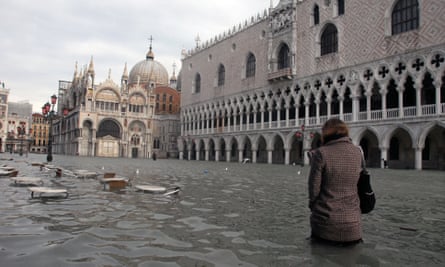
Ho Chi Minh City in Vietnam is also sinking by about 2cm a year – but that’s nothing compared to Jakarta, which is dropping 10-20cm annually. In the past three decades, the city has sunk roughly four metres, rendering its 40-year-old seawall ever-less effective.
Unfortunately for the Indonesian capital, it has pumped out so much groundwater to support its population that the land above is drying out and compacting, and thereby creating a bowl. Rivers that used to flow through the city down to the sea have had to be be diverted, because they cannot drain uphill.
While there are many plans to save Venice – and Ho Chi Minh City and Jakarta are taking the problem seriously – the same cannot be said for Miami, where politicians refuse to admit the city has a severe environmental problem.
Miami’s difficulties are threefold. The Florida resort lies less than 10 feet above sea level; an increasing number of tropical storms are inundating the city; and it is built on a dome of porous limestone which is absorbing the rising seawater. This water then fills the city’s foundations and bubbles up through drains and pipes, forcing sewage upwards and polluting its fresh water. There is every chance Miami may one day become uninhabitable – yet property values continue to rise there, while local politicians refuse to recognise the vulnerability of the city.

Coastal erosion has always been a threat to port cities, but it is even more of a danger to small islands. Jabonga in the Philippines has seen its number of inundations quadruple in recent years – affecting not only housing but the food chain, with damage to the production of rice, corn, vegetables and fruit trees.
In the Maldives, the populations of whole islands are now looking to abandon their homes. The capital Malé, population 153,379 and only four feet above sea level, has used Japanese investment to build a 10-foot sea wall at a cost of $63 million (£41.5m) – but long term, only a stabilisation of rising sea levels will save it and the rest of the islands.
And it’s not just the sea – rainfall is also endangering cities across the world. Recently, an entire summer’s worth of rain fell in one morning on Detroit, overwhelming its outdated sewerage systems. Impoverished by the collapse of America’s car industry, the city is struggling to build a system to cope. Drinking water is also affected because Detroit is particularly vulnerable to water-borne pathogens, and the larvae gruesomely referred to as “Chicago Climate Change Maggots”.
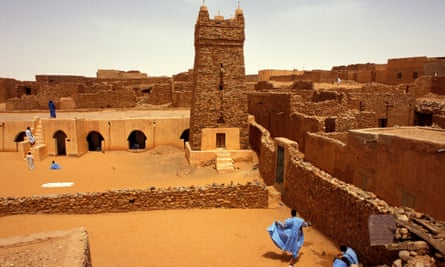
Of course, some cities far away from the sea are also threatened by nature’s encroaching forces. Korla, in China’s Xinjiang province, is one of a number of Chinese desert cities created in the 1960s and 70s for the extraction of oil. Sandstorms are frequent there – an average of 40 days a year – and it is proving difficult to hold back the Takla Makan desert.
The Chinese government tried blowing up mountains to cut down on the wind-tunnel effect that exacerbated the storms hitting Korla, and when that failed erected an enormous “green wall”. Three thousand hectares of trees were planted to hold back the desert, but irrigating these screens is proving very costly – 19,450 yuan (£2,010) per hectare a year, plus pipe maintenance. The rate at which the desert is encroaching on Xinjiang settlements is estimated at 300,000 hectares a year, and Korla looks particularly vulnerable. Once the oil runs out, it will surely be abandoned and simply disappear under the sand.
In Africa, desertification is causing the Sahara to spread south at a rate of 30 miles per year, threatening settlements in northern Mauritania. Over the past 20 years, for example, the desert has grown by more than 260 acres around the trading and religious centre of Chinguetti. A place of Sunni pilgrimage since the 13th century, Chinguetti has seen its population decline from 20,000 people in the mid-20th century to just a few thousand now. Trading has all but ceased as sand piles up in the streets. After visiting in 1996, the writer and photographer Kit Constable Maxwell wrote on his website: “In a few more generations, Chinguetti will be buried without trace, like so many desert realms before it, and its memory will be lost in time …”
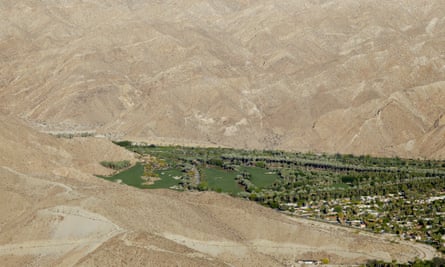
Likewise the Californian resort of Rancho Mirage, near Palm Springs, may have to be abandoned in the next decade. This city is just one example of a problem caused not so much by global warming as human over-expansion in the face of finite resources. California’s dream of farming the desert made sense while its total population remained around half a million (in 1870) – but now the state is home to 38 million people, who between them own 32m vehicles and expect to be surrounded by lawns and golf courses.
The daily water use in Rancho Mirage is more than 200 gallons per person, which is giving rise to a manmade drought. A 25% cut in water consumption has been implemented, but this is unlikely to stabilise the resort, which is surrounded by sand and dust. The long-term answer in California’s desert is likely to be the abandonment of some cities while consolidating the populations of others.
In the “farm city” of Mendota, 350 miles to the north of Rancho Mirage, this man-made drought is increasingly driving farm-workers to travel 60 or 70 miles to look for employment. Mendota’s chances of survival are slim, and it is just one example among many such vulnerable settlements in the region.
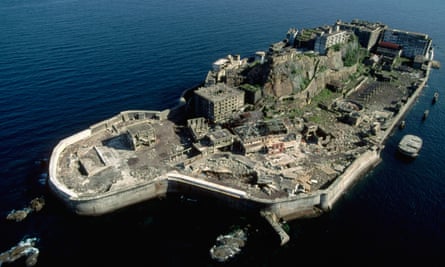
Human flight is the final proof of a city’s disintegration. Once we stop maintaining a city, nature takes over very quickly. Japan’s Hashima Island, now famous for providing the exterior shots of Xavier Bardem’s lair in the James Bond film Skyfall, was turned into a concrete city in 1887 to exploit undersea coal reserves – but in 1974, with coal supplies nearing depletion, the mine was closed and Hashima was abandoned. Now the sea spray is causing its concrete walls to collapse. Unesco has made it a protected industrial heritage site, but without people to do day-to-day maintenance, the island city is crumbling.
There again, humans can often be part of the problem. Centralia in Pennsylvania was, until 1962, a thriving mining town with five hotels, seven churches and 26 saloons. But then a mismanaged clean-up in an underground garbage dump ignited a seam of anthracite eight miles long that proved impossible to extinguish. Soon roads started to melt, and a huge fiery chasm opened up in the back garden of a house, as the ground collapsed into the vast anthracite seam below. An eight-year-old boy was only saved from being burned alive by clinging on to the exposed roots of a tree.
Given that there is enough anthracite coal down there to burn for another 250 years, most people have long since abandoned Centralia (although remarkably, Bill Bryson found 10 people still in residence when he visited to research his book A Walk In The Woods in 1996). Eventually, long before all that anthracite has burned away, the town will probably collapse into the empty seam below and disappear completely.
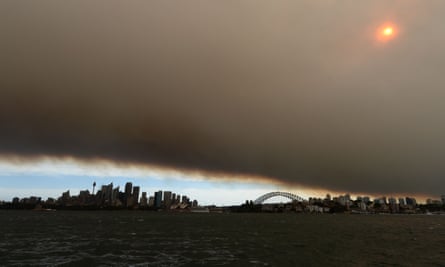
Fire is a growing threat to urban settlements in America – in fact, forest fires cause the most damage after severe storms, with 800 major fire disasters having been declared there between 1953 and 2014. A newly released report by the USDA Forest Service maps the increasing number of urban locations that are particularly vulnerable to wildfire.
Similarly in Australia, some of Victoria’s resorts and several Melbourne suburbs have been placed on a list of the state’s 52 most vulnerable bushfire spots because long-term droughts are making trees highly combustible. It’s unlikely that a forest fire will ever destroy an entire city, but a succession of fires could render it uninhabitable – and abandonment remains one of the most powerful causes of urban collapse.
The ancient Cambodian city of Angkor, and Bagan in Myanmar, are famous examples of what happens when people abandon cities. As with the irradiated settlements around Chernobyl today, human flight lets the foliage in, wooden buildings disintegrate completely, and stone buildings are eventually pulled apart by creepers and roots.
Many cities are fighting a losing battle against the ravages of nature, but is it possible to identify the world’s most vulnerable metropolis? Natural events are notoriously hard to predict – but the prospects for Malé do look particularly grim. For even if its new sea wall continues to be effective, the islands around the Maldives capital are going to disappear before too long. And if they disappear, so does Malé’s raison d’etre.
Follow Guardian Cities on Twitter and Facebook to join the discussion

Comments (…)
Sign in or create your Guardian account to join the discussion